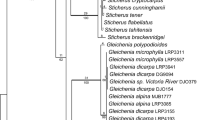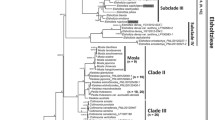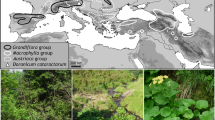Abstract
The classification of Eriosyce subgenus Neoporteria (“subsection” in the sense of Kattermann) and the role of allopatry/sympatry in the diversification of the group were studied by use of cladistic and predictive distribution modeling methods. We reconstructed the phylogenetic relationships of subgenus Neoporteria by analyzing 38 morphological characters and DNA sequences from two chloroplast regions of 21 taxa from the Chilean subsections of Eriosyce using a Bayesian and maximum likelihood phylogenetic framework. Also, we attempted to find out if the divergence between the sister taxa in the Neoporteria group had been caused by allopatric or sympatric mechanisms. The morphology-based analysis placed E. chilensis basal within the Neoporteria clade and suggested a further broadening of the group by including E. taltalensis var. taltalensis, formerly considered a member of subsection Horridocactus. However, the combined DNA data placed E. sociabilis and E. taltalensis var. taltalensis within the Horridocactus clade, and placed E. chilensis with E. subgibbosa var. litoralis. The broad concept of E. subgibbosa sensu Kattermann (comprising seven infraspecific taxa), was rejected by our combined molecular results. Finally, our results corroborated changes in subsection Neoporteria proposed by various authors and suggested further modifications within Neoporteria. The analyses of the degree of geographic overlap of the predicted distributions indicated null overlap between the sister taxa, and one probable hybrid origin of E. chilensis, indicating that evolutionary divergence is mainly caused by an allopatric process associated with climatic tolerance.





Similar content being viewed by others
References
Anderson EF (2001) The cactus family. Timber Press, Portland
Barraclough TG, Vogler AP (2000) Detecting the geographical pattern of speciation from species-level phylogenies. Am Nat 155:419–433
Cereceda P, Osses P, Larraín H, Farías M, Lagos M, Pinto R, Schemenauer RS (2002) Advective orographic and radiation fog in the Tarapacá region Chile. Atmos Res 64:261–271
Cereceda P, Larraín H, Osses P, Farías M, Egaña I (2008) The spatial and temporal variability of fog and its relation to fog oasis in the Atacama Desert Chile. Atmos Res 87:312–323
Darwin C (1859) The origin of species by means of natural selection or the preservation of favoured races in the struggle for life. John Murray, London
Dillon MO, Muñoz-Schick M (1993) A revision of the dioecious genus Griselinia (Griseliniaceae) including a new species from the coastal Atacama Desert of northern Chile. Brittonia 45:261–274
Doyle JJ, Doyle JA (1987) A rapid DNA isolation procedure for small quantities of fresh leaf tissue. Phytochem Bull 19:11–15
Edgar RC (2004) MUSCLE: multiple sequence alignment with high accuracy and high throughput. Nucleic Acids Res 32:1792–1797
Evans MEK, Smith SA, Flynn RS, Donoghue MJ (2009) Climate niche evolution and diversification of the “bird-cage” evening primroses (Oenothera sections Anogra and Kleinia). Amer Naturalist 173:225–240
Ferryman R (2003) Notulae Systematicae Lexicon Cactacearum Spectantes IV. In: Hunt D, Taylor N (eds.) Cactaceae Systematic Initiatives 16:11
Fitzpatrick BM, Turelli M (2006) The geography of mammalian speciation: mixed signals from phylogenies and range maps. Evolution 60:601–615
Futuyma DJ (2005) Evolutionary biology. Sinauer Associates, Sunderland
Graham CH, Ron RR, Santos JC, Schneider CJ, Moritz C (2004) Intergrating phylogenetics and environmental niche models to explore speciation mechanisms in Dendrobatid frogs. Evolution 58:1781–1793
Guerrero PC, Durán AP, Walter HE (2011) Latitudinal and altitudinal patterns of the endemic cacti from the Atacama Desert to Mediterranean Chile. J Arid Environ. doi:10.1016/j.jaridenv.2011.04.036
Hernandez PA, Graham CH, Master LL, Albert DL (2006) The effect of sample size and species characteristics on performance of different species distribution modeling methods. Ecography 29:773–785
Hijmans RJ, Cameron SE, Parra JL, Jones PG, Jarvis A (2005) Very high resolution interpolated climate surfaces for global land areas. Int J Climatol 25:1965–1978
Hoffmann AE (1989) Cactáceas en la flora silvestre de Chile. Fundación Claudio Gay, Santiago de Chile
Hoffmann AE, Walter HE (2004) Cactáceas en la flora silvestre de Chile. Fundación Claudio Gay, Santiago de Chile
Houston J (2006) Variability of precipitation in the Atacama Desert: its causes and hydrological impact. Int J Climatol 26:2181–2198
Huelsenbeck JP, Ronquist F (2001) MRBAYES: Bayesian inference of phylogenetic trees. Bioinformatics 17:745–755
Hunt DR, Taylor N, Charles G (2006) The New Cactus Lexicon. DH books, Milborne Port
Hunt DR (2003) In: Hunt and Taylor (eds) Notulae Systematicae Lexicon Cactacearum Spectantes IV. Cactaceae Systematic Initiatives 16:9
Katinas L, Crisci JV (2000) Cladistic and biogeographic analyses of the genera Moscharia and Polyachyrus (Asteraceae Mutisieae). Syst Bot 25:33–46
Katinas L, Crisci JV (2008) Reconstructing the biogeographical history of two plant genera with different dispersion capabilities. J Biogeogr 35:1374–1384
Kattermann F (1994) Eriosyce (Cactaceae) the genus revised and amplified. Succul Plant Res 1:1–176
Kattermann F (2001) Nomenclatural adjustments in Eriosyce Phil. Cactaceae Syst Ini 12:14
Kozak KH, Wiens JJ (2006) Does niche conservatism promote speciation? A case study in North American salamanders. Evolution 60:2604–2621
Latorre C, Betancourt JL, Quade J (2002) Vegetation invasions into absolute desert: A 45000 yr rodent midden record from the Calama-Salar de Atacama basins northern Chile (lat 22°–24°S). Geol Soc Am Bull 114:349–366
Losos JB, Glor RE (2003) Phylogenetic comparative methods and the geography of spciation. Trends Ecol Evol 18:220–227
Luebert F, Pliscoff P (2006) Sinopsis bioclimática y vegetacional de Chile. Editorial Universitaria, Santiago de Chile
Luebert F, Wen J (2008) Phylogenetic analysis and evolutionary diversification of Heliotropium Sect Cochranea (Heliotropiaceae) in the Atacama Desert. Syst Bot 33:390–402
Maddison WP, Maddison DR (2010) Mesquite: a modular system for evolutionary analysis. Version 2.73 http://mesquiteproject.org
Mayr E (1959) Isolation as an evolutionary factor. Proc Natl Acad Sci USA 103:221–230
Maldonado A, Betancourt JL, Latorre C, Villagrán C (2005) Pollen analyses from a 50000-yr rodent midden series in the southern Atacama Desert (25° 30′S). J Quat Sci 20:493–507
Nixon KC, Davis JI (1991) Polymorphic taxa missing value and cladistic analysis. Cladistics 7:233–241
Nyffeler R, Eggli U (1997) Comparative stem anatomy and systematics of Eriosyce sensu lato (Cactaceae). Ann Bot 80:767–786
Nyffeler R (2002) Phylogenetic relationships in the cactus family (Cactaceae) based on evidence from trnK/matK and trnL-trnF sequences. Am J Bot 89:312–326
Nyffeler R, Eggli U (2010) A farewell to dated ideas and concepts—molecular phylogenetics and a revised suprageneric classification of the family Cactaceae. Schumannia 6:109–149
Nylander JA, Ronquist AF, Huelsenbeck JP, Nieves-Aldrey JL (2004) Bayesian phylogenetic analysis of combined data. Syst Biol 53:47–67
Phillips SJ, Dudík M, Schapire RE (2004) A maximum entropy approach to species distribution modeling In: Proceedings of the twenty-first international conference on machine learning. ACM Press, New York
Phillips SJ, Anderson RP, Schapire RE (2006) Maximum entropy modeling of species geographic distributions. Ecol Model 190:231–259
Posadas P, Crisci JV, Katinas L (2006) Historical biogeography: a review of its basic concepts and critical issues. J Arid Environ 66:389–403
Raxworthy CJ, Ingram CM, Rabibisoa N, Pearson RG (2007) Applications of ecological niche modeling for species delimitation: a review and empirical evaluation using day Geckos (Phelsuma) from Madagascar. Syst Biol 56:907–923
Ritter F (1963) Succulenta (NL) 1:3
Ritter F (1980) Kakteen in Südamerika vol 3. Selbstverlag, Spangenberg
Ritz CM, Martins L, Mecklenburg R, Goremykin V, Hellwig FH (2007) The molecular phylogeny of Rebutia (Cactaceae) and its allies demonstrates the influence of paleogeography on the evolution of South American mountain cacti. Am J Bot 94:1321–1332
Savolainen V, Anstett MC, Lexer C, Hutton I, Clarkson JJ, Norup MV, Powell MP, Springate D, Salamin N, Baker WJ (2006) Sympatric speciation in palms on an oceanic island. Nature 441:210–213
Schlumpberger BO, Raguso RA (2008) Geographic variation in floral scent of Echinopsis ancistrophora (Cactaceae); evidence for constraints on hawkmoth attraction. Oikos 117:801–814
Schemske DW, Bradshaw HD (1999) Pollinator preference and the evolution of floral traits in monkeyflowers (Mimulus). Proc Natl Acad Sci USA 96:11910–11915
Setoguchi H, Osawa TA, Pintaud JC, Jaffré T, Veillon JM (1998) Phylogenetic relationships within Araucariaceae based on rbcL genes sequences. Am J Bot 85:1507–1516
Shaw J, Lickey EB, Schilling EE, Small RL (2007) Comparison of whole chloroplast genome sequences to choose noncoding regions for phylogenetic studies in angiosperms: the tortoise and the hare III. Am J Bot 94:275–288
Stamatakis A, Hoover P, Rougemont J (2008) A rapid bootstrap algorithm for the RAxML web-servers. Syst Biol 75:758–771
Styles EG (1981) Geographical aspects of bird-flower coevolution, with particular reference to Central America. Ann Missouri Bot Gard 68:323–351
Tamura K, Dudley J, Nei M, Kumar S (2007) Molecular evolutionary genetics analysis (MEGA) software version 4.0. Mol Biol Evol 24:1596–1599
Turelli M, Barton NH, Coyne JA (2001) Theory and speciation. Trends Ecol Evol 16:330–3438
Walter HE, Mächler W (2006) Rearrangements in the systematics of Eriosyce napina (Philippi) Kattermann (Cactaceae). Cactus World 24(3):135–143
Walter HE (2008) Floral biology phytogeography and systematics of Eriosyce subgenus Neoporteria (Cactaceae). Bradleya 26:75–98
Wiens JJ (2004a) What is speciation and how should we study it? Am Nat 163:914–923
Wiens JJ (2004b) Speciation and ecology revisited: phylogenetic niche conservatism and the origin of species. Evolution 58:193–197
Wiens JJ, Graham CH (2005) Niche conservatism: integrating evolution ecology and conservation biology. Annu Rev Ecol Syst 36:519–539
Wisz MS, Hijmans RJ, Li J, Peterson AT, Graham CH, Guisan A (2008) Effects of sample size on the performance of species distribution models. Diversity Distrib 14:763–773
Zizka G, Schmidt M, Schulte K, Novoa P, Pinto R, König K (2009) Chilean Bromeliaceae: diversity, distribution and evaluation of conservatio status. Biodiversity Conserv 18:2449–2471
Zuloaga FO, Morrone O, Belgrano MJ (2008) Catálogo de plantas vasculares del cono sur (Argentina, sur de Brasil, Chile, Paraguay y Uruguay). Instituto de Botánica Darwinion. Available via http://wwwdarwineduar/Proyectos/FloraArgentina/FAasp. Accessed 28 May 2009
Acknowledgments
We are grateful to A. Marticorena (CONC), M. Muñoz-Schick (SGO), and I. Meza (SGO) for access to their collection of specimens. We appreciate R. Scherson’s advice on DNA extraction and amplification. We are indebted with P. Posadas, J.V. Crisci, U. Eggli and R. Nyffeler, for their valuable comments and collaboration on different stages of this study. We are also grateful to CONAF for access to the National System of Protected Areas. Computational resources were provided by the Bioportal at the University of Oslo, Norway (http://www.bioportal.uio.no). This research was partially supported by the Instituto de Ecología y Biodiversidad, project ICM-P05-002. PCG acknowledges CONICYT doctoral fellowship and thesis support.
Author information
Authors and Affiliations
Corresponding author
Electronic supplementary material
Below is the link to the electronic supplementary material.
Rights and permissions
About this article
Cite this article
Guerrero, P.C., Arroyo, M.T.K., Bustamante, R.O. et al. Phylogenetics and predictive distribution modeling provide insights into the geographic divergence of Eriosyce subgen. Neoporteria (Cactaceae). Plant Syst Evol 297, 113 (2011). https://doi.org/10.1007/s00606-011-0512-5
Received:
Accepted:
Published:
DOI: https://doi.org/10.1007/s00606-011-0512-5




